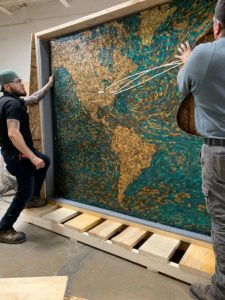Every day, you should view and appreciate great art, specifically if you made it or fell in love with it and bought it. It’s time to discover how to ship a painting if you live far away or want to take your art with you.
Start by analyzing the artwork before deciding how to send a painting.
Think about the materials and pigments the artist chose like:
- If the artwork has a thick canvas or frame
- If it can be folded up
- Consider the other components and elements of the painting
Shipping needs for various art components might vary. For instance, to protect oil paintings from damage, they should first be packed in acid-free paper. While the acid-free paper safeguards the artwork, bubble wrap may be used as a second covering to protect items from bumps during shipping.
 Considering the size and weight of the painting while shipping:
Considering the size and weight of the painting while shipping:
We at Custom Crating and Logistics concentrate on big, hefty, and bulky items. Thus, we are always considering the size and weight of packages. Due to its size and packaging, artwork may readily fit into these categories. It implies that it’s better to weigh and measure your package after constructing the box or crate to contain your painting.
Defining the recipient:
Consider the transport itself once you’ve examined the painting supplies and determined what you need to properly secure. How are you using the artwork? Do you intend to move and bring it with you? Can you transport it somewhere else? Or are you selling it to someone out of the state or country or shipping it to them? How you wrap and transfer the paintings will change depending on the responses.
Shipping paintings over long distances:
You’ll need a carrier to assist if shipping the artwork a long way. Small, local businesses or well-known national names like Custom Crating and Logistics might be examples of this. We are the best choice for painters and gallery owners as we may send artworks a long way. You can transport items one at a time or use a combined freight transfer to ship a complete collection.
Shippers may give various rates, tariffs, or criteria for paintings depending on their judgment of the DIM weight.
 Packaging and protection of painting while shipping over long distances:
Packaging and protection of painting while shipping over long distances:
Let’s move on to the topic you came to this page to learn more about: how to transport a painting and what kind of packaging materials to use. Your best option for choosing how to pack the artwork depends on how it is mounted. A handful of your choices are listed here. Do not forget to handle paintings with care as fragile artifacts.
Protecting your painting:
Cleaning your space is the first step in the packing process. Try to remove debris, dust, or anything that could adhere to your painting. Cleaning serves as a reminder to examine the painting’s frame, glass, and remaining portions for deterioration. Put on gloves to safeguard it if you need to touch the artwork.
Clean up your workplace before laying out the artwork and taking measurements. To document this data and its quality during delivery, take pictures as you measure the object. If the painting is destroyed, you want detailed documentation.
Protection and padding:
You can send paintings in double-walled boxes and corrugated cardboard if they are no larger than 48″ on each side. Large items should always be packed for safety. In any case, you should safeguard the painting itself in some way.
The artwork itself should first receive some protection. Artists universally advise using acid-free glassine paper, albeit this depends on the kind of painting. Archival paper is available for purchase. It safeguards the artwork and reduces the possibility of stains or other types of deterioration. The picture should be completely covered with layers of paper, including the edges. The sheet should be adhered to the frame or back using acid-free tape.
Some painters would stack acid-free paper to enhance thickness while making the border and side protectors. Foam pipe insulation can be chopped and added to the frame or borders. Avoid placing foam directly on sticky oil paintings since doing so might cause the foam to break and become embedded in your artwork.
After the paper and foam have been put, you may either wrap the artwork in bubble wrap or cut pieces of cardboard to preserve it. If you want to place the artwork in a tube, adhere to the wrap. When transporting a painting in a box or crate, think about putting a layer of wrap and then covering the front and back of the artwork with thick cardboard and taping it. Only dried paintings may be layered in this manner.
Tubes and rolled items:
Unmounted canvases may probably be folded up and delivered in a tube. If you roll them, you may send smaller products like posters, prints, and many more through the tubing. It is typical for high-volume manufacturers that could have a workshop where they produce or print their artwork and designs. These objects should be rolled up and put into the shortest tube possible. However, you need enough space to prevent the canvas from being harmed when the customer removes them from the tubing. The tubing should be around three or four inches longer than the painting and wide enough to accommodate a few inches of cushioning materials.
You will need to switch to a more thorough protection strategy if your painting’s canvas is stretched (drawn over a wooden frame) or if it is placed in a frame and protected by glass. Those are more difficult since more things can go wrong during shipping.
Concerns for the Glass and Frame:
If there is a chance of damage, frames can be shielded with foam and other cushioning. Cover your canvas with bubble wrap if it is stretched across an interior structure for complete protection. You can send glass individually or with a painting. The majority of the time, according to artists, you may add things like wrap and materials between the canvas and the glass, but you should still leave some room to allow for movement. It lessens the likelihood of breaking while lowering the possibility that the painting will be harmed. Add cardboard pieces to provide a strong and stable platform for the entire artwork, frame, and glass.
Boxes for your paintings:
To complete shipping artworks, you may make your box or use an existing one. Purchase a carton two to three inches bigger on both sides than the artwork if you’re purchasing one in advance. You will have enough space to cover the painting and to add additional padding or foam to the corners. Every box you utilize should have additional corner protection to reduce the possibility of injury.
Regardless of the path you select, pick a box that you can fill and has space for padding. For extra security while in transit, add layers of protection. And continue using cardboard, paper, and insulation.
Shipping your painting with a reliable carrier:
It’s time to deliver your painting to your shipping partner once you’ve secured and packaged it. You can receive the right shipping choice from carrier retailers and mark your artwork as “fragile.” Your painting will arrive there securely via various ground and freight options.
Ask about freight services if you’re sending a big crate or a lot of artwork. These take longer but can build significant savings if your shipment is large or heavy. You can rely on Custom Crating and Logistics, and we will take good care of your artwork.






